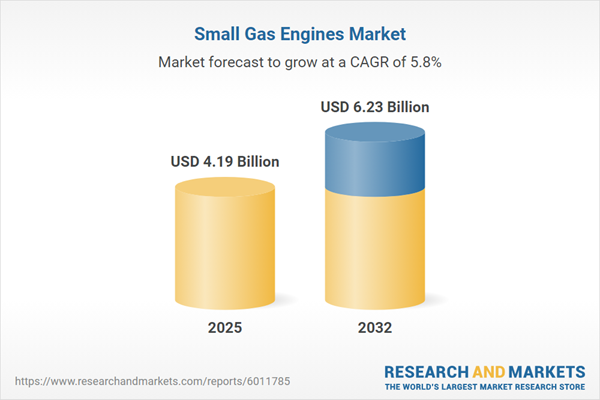Speak directly to the analyst to clarify any post sales queries you may have.
The small gas engines market is evolving rapidly, shaped by regulatory changes, technological innovation, and shifting end-user demands. As industries increasingly require reliable, efficient compact power solutions, stakeholders must understand market drivers, opportunities, and risks to remain competitive in this complex landscape.
Market Snapshot: Small Gas Engines Market Trends and Growth Outlook
The Small Gas Engines Market grew from USD 3.96 billion in 2024 to USD 4.19 billion in 2025. It is expected to continue growing at a CAGR of 5.83%, reaching USD 6.23 billion by 2032.
This robust expansion reflects rising demand for fuel-efficient, durable engines across diverse applications from agriculture to commercial landscaping, supported by global industrial activity and expanding infrastructure investments.Scope & Segmentation: Comprehensive Market Coverage
This report provides detailed analysis of the small gas engines market across all major segments, technologies, and regions, offering actionable insight for decision-makers.
- Applications: Agricultural, Construction & Utility, Industrial, Lawn & Garden
- Engine Types: Horizontal Shaft, Vertical Shaft
- Power Output: 5 to 10 HP, Above 10 HP, Below 5 HP
- Fuel Types: CNG, Gasoline, LPG
- Cylinder Count: Multi Cylinder (3 Cylinder, 4 Cylinder & Above), Single Cylinder, Twin Cylinder
- Cooling Methods: Air Cooled, Liquid Cooled
- Distribution Channels: OEM, Online, Retail
- Geographic Regions: Americas (North America: United States, Canada, Mexico; Latin America: Brazil, Argentina, Chile, Colombia, Peru), Europe, Middle East & Africa (Europe: United Kingdom, Germany, France, Russia, Italy, Spain, Netherlands, Sweden, Poland, Switzerland; Middle East: United Arab Emirates, Saudi Arabia, Qatar, Turkey, Israel; Africa: South Africa, Nigeria, Egypt, Kenya), Asia-Pacific (China, India, Japan, Australia, South Korea, Indonesia, Thailand, Malaysia, Singapore, Taiwan)
- Key Industry Players: Honda Motor Co., Ltd., Briggs & Stratton Corporation, Kawasaki Heavy Industries, Ltd., Kohler Co., Yamaha Motor Co., Ltd., Subaru Corporation, Loncin Corporation, Champion Power Equipment, Inc., Generac Power Systems, Inc., Yanmar Co., Ltd., Kubota Corporation, DEUTZ AG, Cummins Inc., Husqvarna AB, STIHL Holding AG & Co. KG
Key Takeaways: Strategic Insights for Senior Leaders
- Technological advancements in engine design are improving fuel efficiency, reducing emissions, and strengthening durability.
- New environmental regulations and growing sustainability concerns are accelerating the shift toward cleaner fuel technologies and lower-noise operation, with manufacturers investing in emission-reduction strategies.
- The integration of digital technologies, including sensors and remote diagnostics, enables predictive maintenance and operational optimization, enhancing reliability for end-users.
- Modular engine architectures and additive manufacturing are streamlining customization, shortening development cycles, and lowering production lead times.
- Regional demand is influenced by factors such as rural electrification in Latin America, sustainability leadership in Europe, and robust infrastructure development in Asia-Pacific.
- Competitive pressures from electric and hybrid alternatives are pushing ongoing research into alternative fuel compatibility and lean-combustion technologies.
Tariff Impact: Navigating U.S. 2025 Tariffs
The introduction of U.S. tariffs in 2025 has increased landed costs for engines and components sourced from Asia, prompting OEMs to reassess procurement, pursue nearshoring, and implement supply chain adjustments. These policy shifts have resulted in investments toward domestic manufacturing and regional partnerships, while customers are seeking added value to offset cost pressures. The sector’s agility in adapting to these dynamics underscores its resilience and capacity to sustain dependable power solutions amidst regulatory challenges.
Methodology & Data Sources
This report employs a multi-faceted research approach, combining structured interviews with industry executives and technical experts, and secondary analysis from industry publications, technical journals, and government reports. Quality assurance protocols, including triangulation and peer reviews, validate all findings to ensure accuracy and depth.
Why This Report Matters
- Enables strategic planning by mapping evolving technologies, segment drivers, and regulatory impacts across all major regions.
- Provides actionable guidance for supply chain risk mitigation, product development, and digital integration in response to changing market dynamics.
- Delivers an unbiased, credible foundation for investment, expansion, and partnership decisions in a rapidly evolving sector.
Conclusion
Senior decision-makers equipped with the insights from this report can confidently navigate the complexities of the small gas engines market. In-depth analysis ensures readiness to capitalize on new opportunities, adapt to regulatory changes, and drive long-term success in an evolving competitive environment.
Additional Product Information:
- Purchase of this report includes 1 year online access with quarterly updates.
- This report can be updated on request. Please contact our Customer Experience team using the Ask a Question widget on our website.
Table of Contents
3. Executive Summary
4. Market Overview
7. Cumulative Impact of Artificial Intelligence 2025
Companies Mentioned
The companies profiled in this Small Gas Engines market report include:- Honda Motor Co., Ltd.
- Briggs & Stratton Corporation
- Kawasaki Heavy Industries, Ltd.
- Kohler Co.
- Yamaha Motor Co., Ltd.
- Subaru Corporation
- Loncin Corporation
- Champion Power Equipment, Inc.
- Generac Power Systems, Inc.
- Yanmar Co., Ltd.
- Kubota Corporation
- DEUTZ AG
- Cummins Inc.
- Husqvarna AB
- STIHL Holding AG & Co. KG
Table Information
| Report Attribute | Details |
|---|---|
| No. of Pages | 189 |
| Published | October 2025 |
| Forecast Period | 2025 - 2032 |
| Estimated Market Value ( USD | $ 4.19 Billion |
| Forecasted Market Value ( USD | $ 6.23 Billion |
| Compound Annual Growth Rate | 5.8% |
| Regions Covered | Global |
| No. of Companies Mentioned | 16 |









